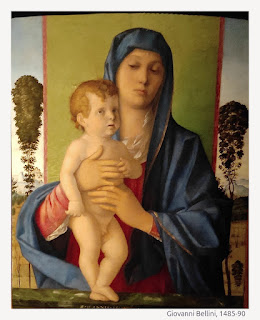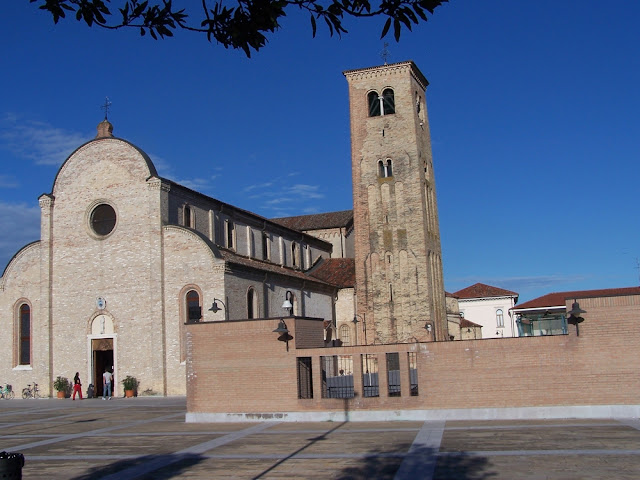The renaissance period introduced the ideas of three-dimensional depth, realism, perspective, colour-tones and light in paintings, based on new understandings from different sciences such as anatomy, physics, mathematics, geology and natural sciences occurring in that period.
This post focuses on the evolution of a renaissance period artist through 11 paintings on the theme of "Madonna and child Jesus". The artist is Giovanni Bellini and all the paintings are from the Accademia museum in Venice.
The image below is that of a telero (huge painting covering an entire wall) started by Giovanni Bellini in 1515-16, left incomplete due to his death. (Click on the images for a bigger view)
The Bellini Bottega in Venice
In that period, the artists worked in Bottega or workshops, where the master artist had many apprentice and helpers. Jacopo Bellini, Giovanni's father, was a renowned Venetian artist in Venice. One of Jacopo's famous works is a tall mosaic inside St Marks basilica in Venice, known as "Mosaic of Visitation".
Giovanni Bellini, also called Giambellino, was born around 1930-35. He is considered as one of the great masters of early Venetian renaissance art. Giovanni had learned the art from his brother and father, was also influenced by his brother-in-law Andrea Mantegna, as well as other artists. Giovanni played an important role in developing the ideas of "tonality" in art, ensuring an overall tone for the painting and a smooth passage of tones in different parts of the painting.
Before presenting his art-works, let me briefly introduce the Accademia museum of Venice, where you can admire the originals of all the paintings presented in this post.
Accademia Museum
This museum hosts some of the masterpieces of renaissance period art by maestros like Tiziano (Titan), Tintoretto, Canaletto, Tiepolo, Hans Memling & Hieronymus Bosch. It is situated close to the Accademia bridge (orginally called Ponte della Carità, inaugurated in 1854). If you like renaissance art, do not miss visiting this museum during your visit to Venice.
The building hosting the Accademia museum today, was once a convent and a church (Santa Maria della Carità church). Under Napoleon's rule in late 18th century, the religious persons from the church and the nearby convent were sent away. In 1807, the old Accademia museum was shifted in those buildings.
Giovanni Bellini's "Madonna and the Child" Series of Paintings
Bellini made a series of paintings of Madonna with the child Jesus. Let me now show you 10 paintings from that series present in the Accademia museum, so that you can appreciate his evolution as a painter.
There is an 11th painting at the end of this post, from his series on the theme of Pietà.
1. From 1448
I am not sure how old was Giovanni when this painting was made and how much did he actually contribute to it. The madonna of this painting does not look very young. Baby Jesus, sitting on a parapet, is holding an apple in his left hand and two fingers raised showing his dual (human and divine) nature. Madonna is expressionless while the child has a knowing expression, much wiser than his age.
2. From 1455
This painting was done when Giovanni was about 20 years old. It is simpler with fewer colours compared to the first one. The baby wearing a black dress, looks younger but still has a knowing expression while he holds his mother's chin with his hand.
3. From 1470
When this painting was done, Giovanni was 35 years old and clearly it is a more mature work, even if it not an oil painting on canvas like the others. Madonna seems to be lit by the light, with a blue sky behind her. Her face has a serenity while looking down at her sleeping son, lying nude, his hand hanging down, almost like a glimpse of the future awaiting them. There is a sense of three-dimensionality, proportions and perspective in this work.
4. From 1475
Giovanni made this when he was forty. He has light coming in from upper right side, lighting up Madonna's serene and young face, while the light on the baby is more diffused. The baby has a more innocent face, and he makes the sign of his dual nature with this right hand, while his left hand grips his mother's thumb.
5. From 1480
By now, Giovanni was 45 years old and clearly more skilled as a painter. The whole canvas seems lit by light with bright colours. The background has a light blue sky, fluffy clouds and the Euganei hills near Padua. The baby has a knowing and petulant look, as he holds his right hand in the two-fingers sign while his left hand discreetly seeks his mother's touch.
6. From 1485-90
Now Giovanni has crossed fifty years, he is recognised as a maestro. Perhaps, this means that now he can experiment and try new colours and ideas. The most distinctive change in the painting is the use of bright red colours in Madonna's gown and the heads and wings of the six cherubs on the clouds floating above. The baby seems to be wearing a modern looking night-shirt. The baby also has a more child like expression and seems to be talking to his mother.
7. From 1485-90
This is also from the same period. In this, the two have a green screen behind, the surface of the parapet is painted green, and in the background on the two sides there are two trees. The baby is nude, has a more child like expression and his left hand holds his mother's fingers. Once again the whole canvas seems to be lit by light.
8. From 1488 (With St Catherine and Magdalene)
This is a more complex work. Compared to the two women saints on the two sides, dressed in rich clothes and wearing jewellery, Madonna looks similar to the other paintings above. The baby seems lost in ecstasy. While the background is dark, the 4 figures seem lit by an external light, creating a few shadows. It seems to have clear Flemish or Dutch influences.
9. From 1490 (With St Paul and St George)
Like one above, this one also has two figures standing on both sides of the mother and child. However, this painting has much more in common with his other works - light blue sky with clouds, a red screen behind them, all the persons lit by a light coming from the left with a hint of shadows in the right side of the canvas.
10. From 1503 (With St John Baptist and a Woman)
This painting was done when Giovanni was 68 years old and it is even more complex, with a detailed urban background with the Vicentino mountains behind them - the houses have a distinct look, may be it shows the city of Bassano. Sheep are grazing on the grassy hills (click on the picture to see a bigger version for the sheep). It is bathed in light with shades of liliacs, pinks, green and light blues. Madonna has a soft and innocent expression. The skin tones of Madonna and the woman on the right seem to have the red tones associated with Titan.
11. From 1505 - Pietà with Madonna and the Dying Jesus
The last painting is from the Pietà series, and is from 1505, when Giovanni was 70 years old. The white-haired Madonna's face is etched with lines of sorrow. A dramatic touch is given by the broken tree on the left of the canvas. The background is in the shade of orange-yellow seems to show Padua with Euganei hills and Vicentino mountains behind. Once again, the whole canvas seems to be lit all over with a diffused light and few shadows. (You can click on all the images for a bigger view.)
Things I Noticed in the Paintings
I think that as Giovanni grew older and more skilled, his works assumed more renaissance characteristics - they seem more three-dimensional, more realistic, while the proportions and perspectives improve.
In most of his paintings, the Madonna has an innocent or an aloof look, she does not seem to be looking at you. I also noticed that in many paintings, her little finger seems to be bent or crooked in the middle - it does not seem very natural. Try bending your finger like that and you will see what I mean.
On the other hand, the baby Jesus has a more knowing look, creating a kind of dissonance because his facial expressions are more adult-like. At the same time, the child's proportions do not always look right. For example in painting number 10 above, the child seems to be too long. Child's ecstasy, with his eyes turning up, in image 8 also made me feel a little anxious.
I love the light and vivid colours that seem to illuminate many of his works. They lack the light and shadow effects (chiaroscuro), which would become a dominant part of later renaissance art.
I also love the tender affection between the mother and the baby, expressed in the way the boy holds his mother's thumb or touches her hand.
To Conclude
To look at the different paintings of Giovanni Bellini in a chronological manner gives us an idea of his evolution as an artist. At the same time, it gives us an idea of how the renaissance ideas of art were evolving.
Leonardo da Vinci was born in 1452 and his Monalisa was painted in early 1500s. Michelangelo was born in 1475 and his frescoes of Universal Judgement in Vatican were painted around 1540. Thus, the art of Giovanni Bellini needs to be seen in the context of all the other artists, as they exchanged ideas, knowledge and techniques.
All the paintings presented in this post are from Accademia museum in Venice. To feel their full impact, you need to look at them in the museum. For example, the sensation of light when you look at painting number 10 above is absolutely incredible. When I saw it, I was transfixed.
BTW, the Telero shown in the first image above was commissioned to Giovanni Bellini in 1515, when he had turned eighty. He was unable to finish it, as he died in 1516. It was completed many years later by another artist, Vittore Belliniano.
I have been to the Accademia museum a few times, and every time I go there I discover new works which I had not noticed earlier!
*****














































